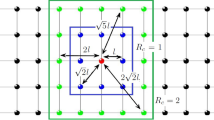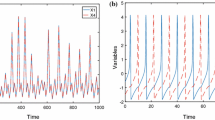Abstract
In network analysis, using discrete models, known as map models, brings advantages to the network since such models are more flexible and efficient than continuous ones. Memristor is another concept that brings a significant nonlinearity to the system. Therefore, different initially discrete or discretized memristive maps can be found in the literature. To benefit from the advantages of the memristive maps and to model different multi-level neural interactions, in this paper, we investigate the synchronization and chimera state in a multiplex network of discretized Hindmarsh–Rose maps with a flux-controlled memristor. The studied multiplex network was considered to have two layers, each having a different small-world structure with 50 neurons, and corresponding neurons from different layers were linked. In the constructed two-layer network, the influence of different intra-layer couplings on synchronization was studied, while chemical synapses were considered the only inter-layer neural interactions. We found that when intra-layer neurons interacted electrically, they could achieve synchronization as the electrical coupling strength increased. However, when neurons were linked through electrical and chemical couplings, they could not reach a synchronous state. Similarly, chemically coupled intra-layer neurons could not achieve synchronization as well. Also, we observed that chemical inter-layer interactions could lead to the formation of coherent and incoherent clusters. Thus, in a weak intra-layer coupling value, the chimera state was found by increasing the inter-layer coupling strength.











Similar content being viewed by others
Data availability
Data sharing not applicable to this article as no datasets were generated during the current study.
References
J. Ma, J. Tang, A review for dynamics in neuron and neuronal network. Nonlinear Dyn. 1–10 (2017)
A.L. Hodgkin, A.F. Huxley, A quantitative description of membrane current and its application to conduction and excitation in nerve. J. Physiol. 117(4), 500 (1952)
W.W. Lytton, Computer modelling of epilepsy. Nat. Rev. Neurosci. 9(8), 626–637 (2008)
W. Hao, A. Friedman, Mathematical model on Alzheimer’s disease. BMC Syst. Biol. 10(1), 1–18 (2016)
S. Bakshi, V. Chelliah, C. Chen, P.H. van der Graaf, Mathematical biology models of Parkinson’s disease. CPT Pharmacometr. Syst. Pharmacol. 8(2), 77–86 (2019)
J. Hindmarsh, R. Rose, A model of neuronal bursting using three coupled first order differential equations. Proc. R. Soc. Lond. B Biol. Sci. 221(1222), 87–102 (1984)
R. FitzHugh, Impulses and physiological states in theoretical models of nerve membrane. Biophys. J. 1(6), 445–466 (1961)
C. Morris, H. Lecar, Voltage oscillations in the barnacle giant muscle fiber. Biophys. J. 35(1), 193–213 (1981)
N.F. Rulkov, Modeling of spiking-bursting neural behavior using two-dimensional map. Phys. Rev. E 65(4), 041922 (2002)
B. Ibarz, J.M. Casado, M.A. Sanjuán, Map-based models in neuronal dynamics. Phys. Rep. 501(1–2), 1–74 (2011)
N. Zandi-Mehran, S. Panahi, Z. Hosseini, S.M.R.H. Golpayegani, S. Jafari, One dimensional map-based neuron model: a phase space interpretation. Chaos Solitons Fractals 132, 109558 (2020)
D.R. Chialvo, Generic excitable dynamics on a two-dimensional map. Chaos Solitons Fractals 5(3–4), 461–479 (1995)
B. Li, Z. He, Bifurcations and chaos in a two-dimensional discrete Hindmarsh-Rose model. Nonlinear Dyn. 76(1), 697–715 (2014)
E.M. Izhikevich, F. Hoppensteadt, Classification of bursting mappings. Int. J. Bifurc. Chaos 14(11), 3847–3854 (2004)
L. Chua, Memristor-the missing circuit element. IEEE Trans. Circuit Theory 18(5), 507–519 (1971)
H. Bao, A. Hu, W. Liu, B. Bao, Hidden bursting firings and bifurcation mechanisms in memristive neuron model with threshold electromagnetic induction. IEEE Trans. Neural Netw. Learn. Syst. 31(2), 502–511 (2019)
L. Chua, V. Sbitnev, H. Kim, Hodgkin–Huxley axon is made of memristors. Int. J. Bifurc. Chaos 22(03), 1230011 (2012)
K. Usha, P. Subha, Hindmarsh-Rose neuron model with memristors. Biosystems 178, 1–9 (2019)
Z.T. Njitacke, C.N. Takembo, J. Awrejcewicz, H.P.E. Fouda, J. Kengne, Hamilton energy, complex dynamical analysis and information patterns of a new memristive FitzHugh-Nagumo neural network. Chaos Solitons Fractals 160, 112211 (2022)
G. Qi, Y. Wu, J. Hu, Abundant firing patterns in a memristive Morris-Lecar neuron model. Int. J. Bifurc. Chaos 31(11), 2150170 (2021)
H. Bao, Z. Hua, H. Li, M. Chen, B. Bao, Discrete memristor hyperchaotic maps. IEEE Trans. Circuits Syst. I Regul. Pap. 68(11), 4534–4544 (2021)
K. Li, H. Bao, H. Li, J. Ma, Z. Hua, B.C. Bao, Memristive Rulkov neuron model with magnetic induction effects. IEEE Trans. Ind. Inform. 1 (2021)
H. Bao, Z. Hua, W. Liu, B. Bao, Discrete memristive neuron model and its interspike interval-encoded application in image encryption. Sci. China Technol. Sci. 64(10), 2281–2291 (2021)
M. Mehrabbeik, F. Parastesh, J. Ramadoss, K. Rajagopal, H. Namazi, S. Jafari, Synchronization and chimera states in the network of electrochemically coupled memristive Rulkov neuron maps. Math. Biosci. Eng. 18(6), 9394–9409 (2021)
B. Ramakrishnan, M. Mehrabbeik, F. Parastesh, K. Rajagopal, S. Jafari, A new memristive neuron map model and its network’s dynamics under electrochemical coupling. Electronics 11(1), 153 (2022)
F. Parastesh, M. Mehrabbeik, K. Rajagopal, S. Jafari, M. Perc, Synchronization in Hindmarsh-Rose neurons subject to higher-order interactions. Chaos Interdiscip. J. Nonlinear Sci. 32(1), 013125 (2022)
F. Parastesh et al., Chimeras. Phys. Rep. 898, 1–114 (2021)
A. Bandyopadhyay, S. Kar, Impact of network structure on synchronization of Hindmarsh-Rose neurons coupled in structured network. Appl. Math. Comput. 333, 194–212 (2018)
S. Pusil, S.I. Dimitriadis, M.E. López, E. Pereda, F.J.N.C. Maestú, Aberrant MEG multi-frequency phase temporal synchronization predicts conversion from mild cognitive impairment-to-Alzheimer’s disease. NeuroImage Clin. 24, 101972 (2019)
A.S. Reis, K.C. Iarosz, F.A. Ferrari, I.L. Caldas, A.M. Batista, R.L. Viana, Bursting synchronization in neuronal assemblies of scale-free networks. Chaos Solitons Fractals 142, 110395 (2021)
E. Zambrano-Serrano, J.M. Munoz-Pacheco, A. Anzo-Hernández, O.G. Félix-Beltrán, D.K. Guevara-Flores, Synchronization of a cluster of β-cells based on a small-world network and its electronic experimental verification. Eur. Phys. J. Spec. Top. 231(5), 1035–1047 (2022)
E. Rybalova, T. Vadivasova, G. Strelkova, V.S. Anishchenko, A. Zakharova, Forced synchronization of a multilayer heterogeneous network of chaotic maps in the chimera state mode. Chaos Interdiscip. J. Nonlinear Sci. 29(3), 033134 (2019)
B. Yan, F. Parastesh, S. He, K. Rajagopal, S. Jafari, M. Perc, Interlayer and intralayer synchronization in multiplex fractional-order neuronal networks. Fractals (2022)
M. Winkler, J. Sawicki, I. Omelchenko, A. Zakharova, V. Anishchenko, E. Schöll, Relay synchronization in multiplex networks of discrete maps. EPL 126(5), 50004 (2019)
B.K. Bera, S. Rakshit, D. Ghosh, Intralayer synchronization in neuronal multiplex network. Eur. Phys. J. Spec. Top. 228(11), 2441–2454 (2019)
V.A. Maksimenko et al., Excitation and suppression of chimera states by multiplexing. Phys. Rev. E 94(5), 052205 (2016)
E. Rybalova, A. Zakharova, G. Strelkova, Interplay between solitary states and chimeras in multiplex neural networks. Chaos Solitons Fractals 148, 111011 (2021)
J.L. Hindmarsh, R.M. Rose, A model of the nerve impulse using two first-order differential equations. Nature 296(5853), 162–164 (1982)
D.J. Watts, S.H. Strogatz, Collective dynamics of ‘small-world’networks. Nature 393(6684), 440–442 (1998)
S. Rakshit, A. Ray, B.K. Bera, D. Ghosh, Synchronization and firing patterns of coupled Rulkov neuronal map. Nonlinear Dyn. 94(2), 785–805 (2018)
S.F. Muldoon, E.W. Bridgeford, D.S. Bassett, Small-world propensity and weighted brain networks. Sci. Rep. 6(1), 1–13 (2016)
Acknowledgements
This work was supported by the grants from the National Natural Science Foundations of China under Grant nos. 12172066 and 61801054, the Natural Science Foundations of Jiangsu Province, China under Grant nos. BK20160282, 333 Project of Jiangsu Province of China, and Qinglan Project of Jiangsu Province of China.
Author information
Authors and Affiliations
Corresponding author
Rights and permissions
Springer Nature or its licensor (e.g. a society or other partner) holds exclusive rights to this article under a publishing agreement with the author(s) or other rightsholder(s); author self-archiving of the accepted manuscript version of this article is solely governed by the terms of such publishing agreement and applicable law.
About this article
Cite this article
Fan, W., Wu, H., Li, Z. et al. Synchronization and chimera in a multiplex network of Hindmarsh–Rose neuron map with flux-controlled memristor. Eur. Phys. J. Spec. Top. 231, 4131–4141 (2022). https://doi.org/10.1140/epjs/s11734-022-00720-5
Received:
Accepted:
Published:
Issue Date:
DOI: https://doi.org/10.1140/epjs/s11734-022-00720-5




